Sea holly varieties: 16 types of eryngium for architectural interest
Try these dramatic sea holly varieties for year-long displays of thistle-style flower heads and highly textural foliage
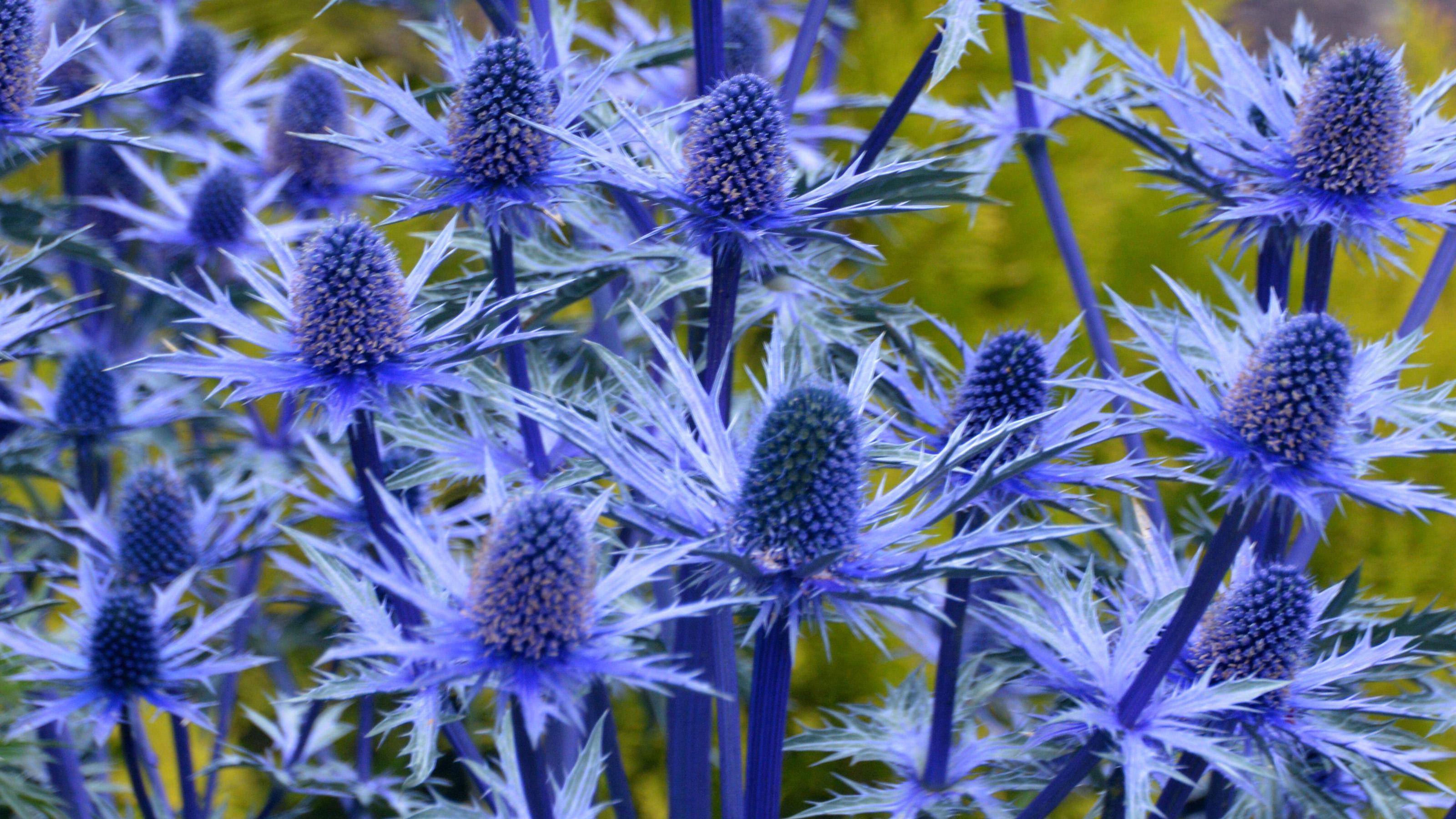

There are 250 species of sea holly varieties to choose from, spanning dainty ground-covering breeds and towering statuesque spikes. Often associated with coastal gardening, these showstopping perennials are so hardy and adaptable that they can work in all manner of modern flower beds and free-flowing displays. The architectural grandeur of sea hollies (or eryngiums) makes them ideal for contemporary naturalistic plantings, while their love of ample drainage makes them ideal for gravel gardens.
Resembling sophisticated thistles, sea hollies have cone flowerheads surrounded by starry collars of barbed bracts. Sometimes these plants glow violet blue, or seem to shimmer like metal in the sun. As well as the popular blue forms, there are lesser-known types of eryngium with ivory, silver, and claret blooms, some with lush blade-like foliage. Eryngiums are far more varied than most gardeners realise. While they appreciate full sun and poor soil, you’ll find they can thrive in any setting, from modest courtyards to intensely ornamental cottage garden displays.
Sea hollies are a must-have in wildlife gardens and provide a rich supply of nectar for pollinators. Bee expert Dave Goulson rates Eryngium planum ‘Blaukappe’ as one of the best for bees. For cut or dried flowers, the generous ruffs of E. alpinum are superb and surprisingly soft to the touch. And for layers in a border, airy E. × tripartitum has an evocative ‘see-through’ quality. There are many other types to try in your flower bed ideas, depending on your taste and space. Sea holly can add year-long texture and structure – so check out some of the most exquisite varieties to plant now.
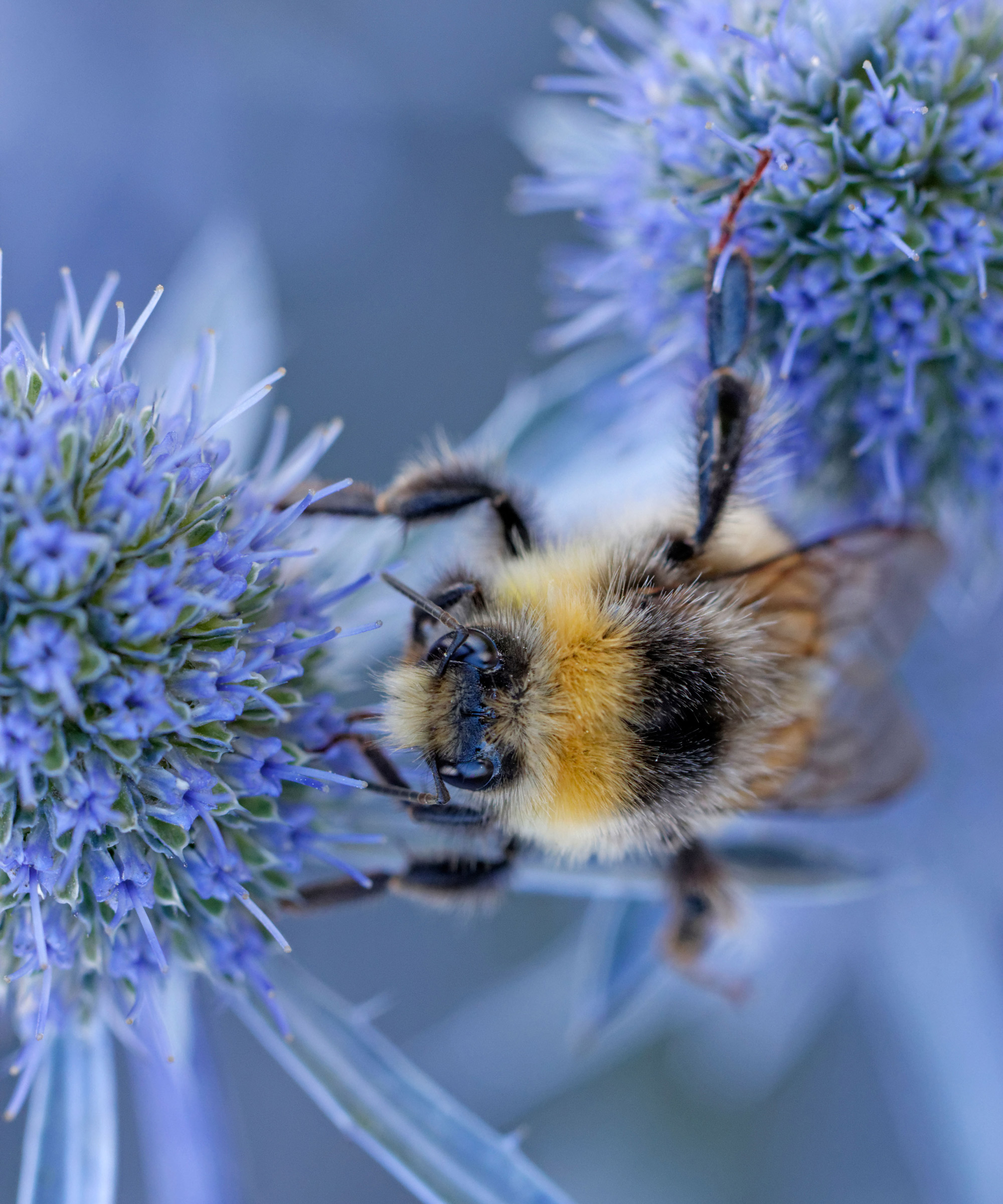
‘Blaukappe’ is one of the best types of eryngium for attracting bees
Try these 16 sea holly varieties for drama and texture
Many sea holly varieties are native to the Americas and Europe. E. maritimum is a wildflower of the British coast, thriving on sun-baked sand dunes and shingle. Most types of eryngium are sun-worshippers and the majority demand good drainage, suffering if waterlogged over winter. They also love an open position, whether that is standing proud in garden borders; flanking a gravel garden with airy perennials; or delicately grown alongside low plants such as Californian poppies.
Giving them prominence makes the most of their structure, which is not only superb when they flower from mid summer to early fall, but also as part of winter landscaping, when their striking seed heads are encrusted with sparkling frosts.
1. ‘Big Blue’ AGM
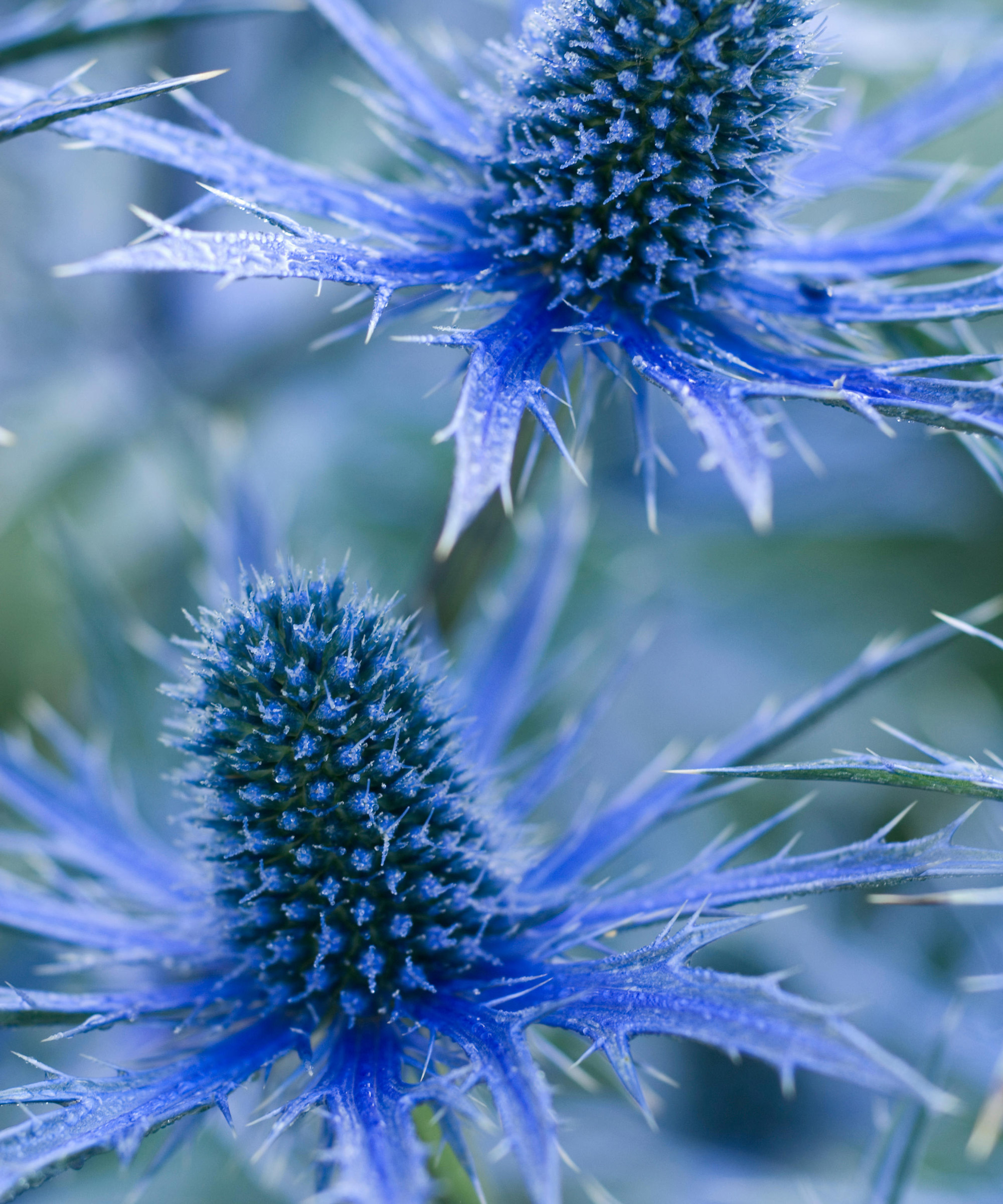
‘Big Blue’ AGM
- Hardiness: USDA 5-9 (UK H5)
- Height: 30in (75cm)
- Spread: 12in (30cm)
- Best for: a blue border
Award of Garden Merit (AGM) winner Eryngium × zabelii ‘Big Blue’ is one of the most dynamic blue sea holly varieties you can grow. These plants work well in tandem with many types of delphiniums for lovers of cobalt, cerulean and lapis tones. You can also grow them with Hylotelephium ‘Matrona’ in very well-drained soil in full sun.
Other than its basal green leaves, the entirety of this sea holly (the summer cone flowerheads, surrounded by a ruff of bracts and the branching stems) can sometimes glow an enchanting shade of blue – it’s almost as if the plant has been dipped in ink!
2. ‘Blue Hobbit’ AGM
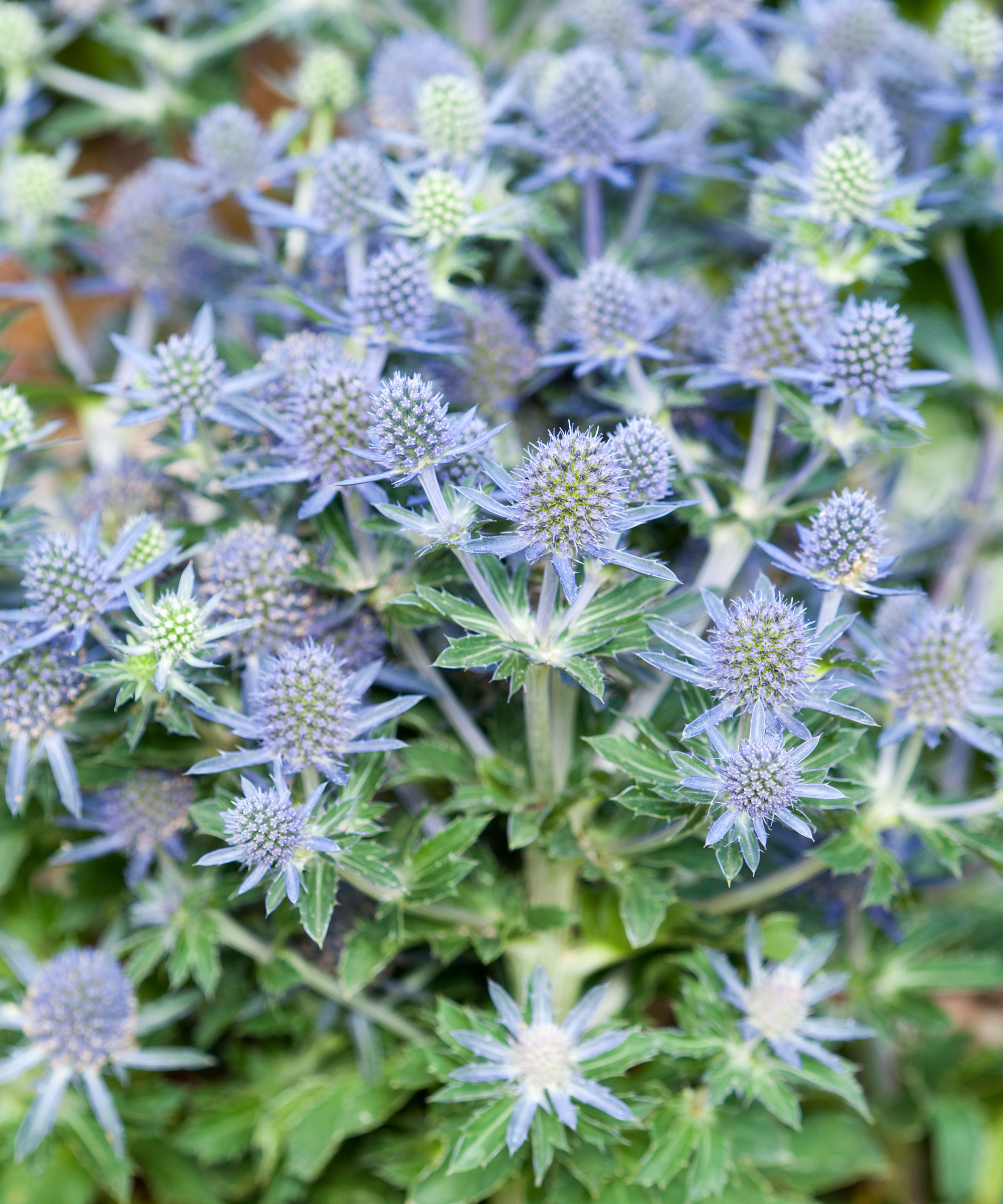
‘Blue Hobbit’ AGM
- Hardiness: USDA 4-8 (UK H5)
- Height: 12in (30cm)
- Spread: 12in (30cm)
- Best for: containers
If you’re looking for a compact sea holly to grow in the front of a border or a well-drained container, this is the one for you. E. planum ‘Blue Hobbit’ is well suited to cool-toned garden color schemes and is ideal if you grow thyme alongside it in full sunshine and well-drained soil.
This is one of the smaller types of eryngium and has small thimble-like flowerheads surrounded by short bracts on branching stems. These all present in a rich shade of steel blue in mid to late summer, before morphing into attractive seed heads for late season displays.
- Buy ‘Blue Hobbit’ in the UK: view at You Garden
- Buy ‘Blue Hobbit’ in the UK: view at Thompson & Morgan
3. E. × tripartitum AGM
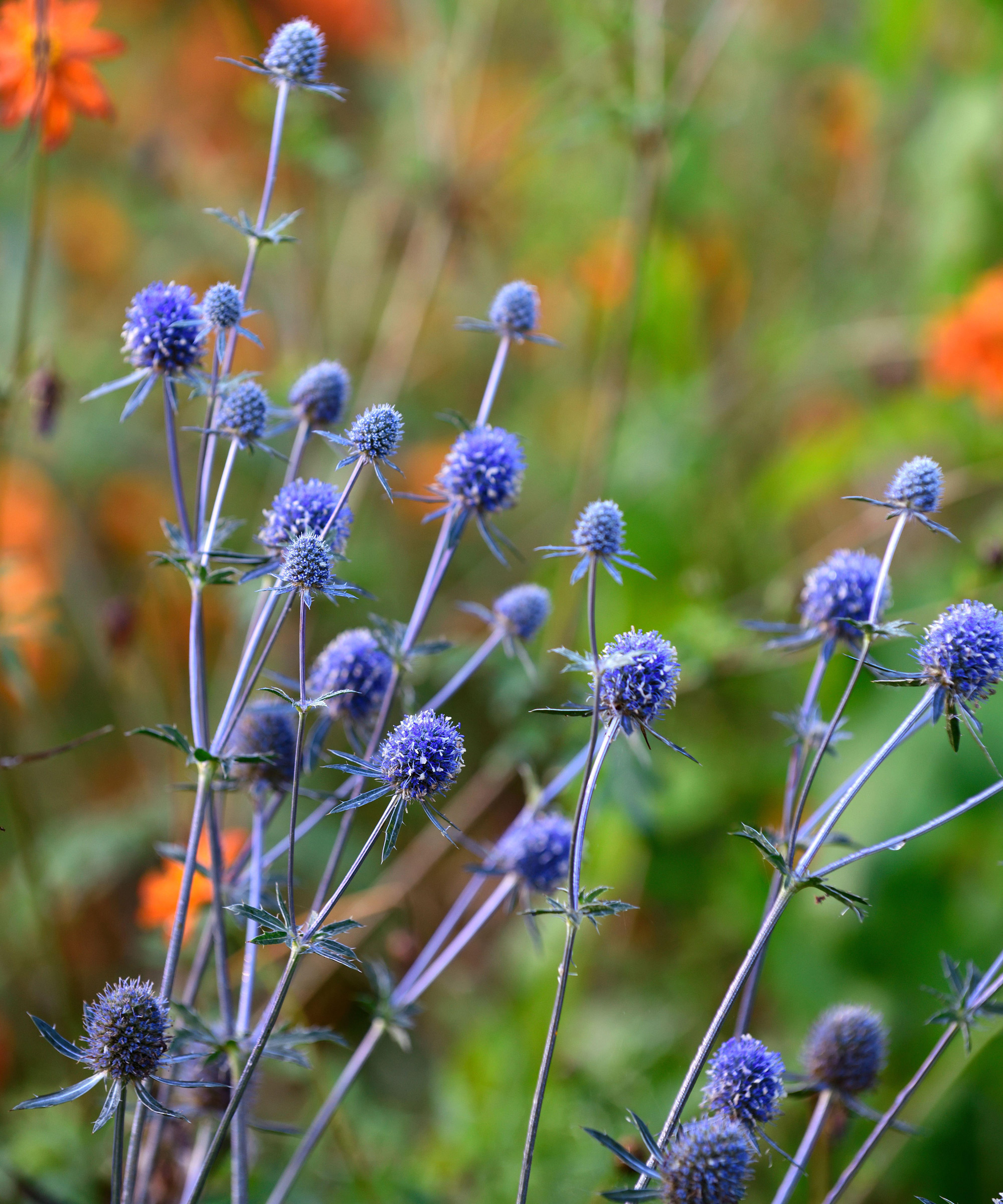
E. × tripartitum AGM
- Hardiness: USDA 5-9 (UK H5)
- Height: 2ft (60cm)
- Spread: 1ft (30cm)
- Best for: a see-through effect
E. × tripartitum AGM is one of the daintier looking types of eryngium. This sea holly is a slender form with small, egg-shaped flower heads and little spike bracts on very slim branching stems. It works well grown with different types of ornamental grass such as stipa grasses in full sun.
The whole plant is an ethereal shade of blue that seems to shimmer from mid summer through to early fall. It has a striking ‘see-through’ effect, allowing you to glimpse the plants positioned behind it, and therefore it is a great sea holly to choose to help create layers in the border.
4. ‘Silver Ghost’ AGM
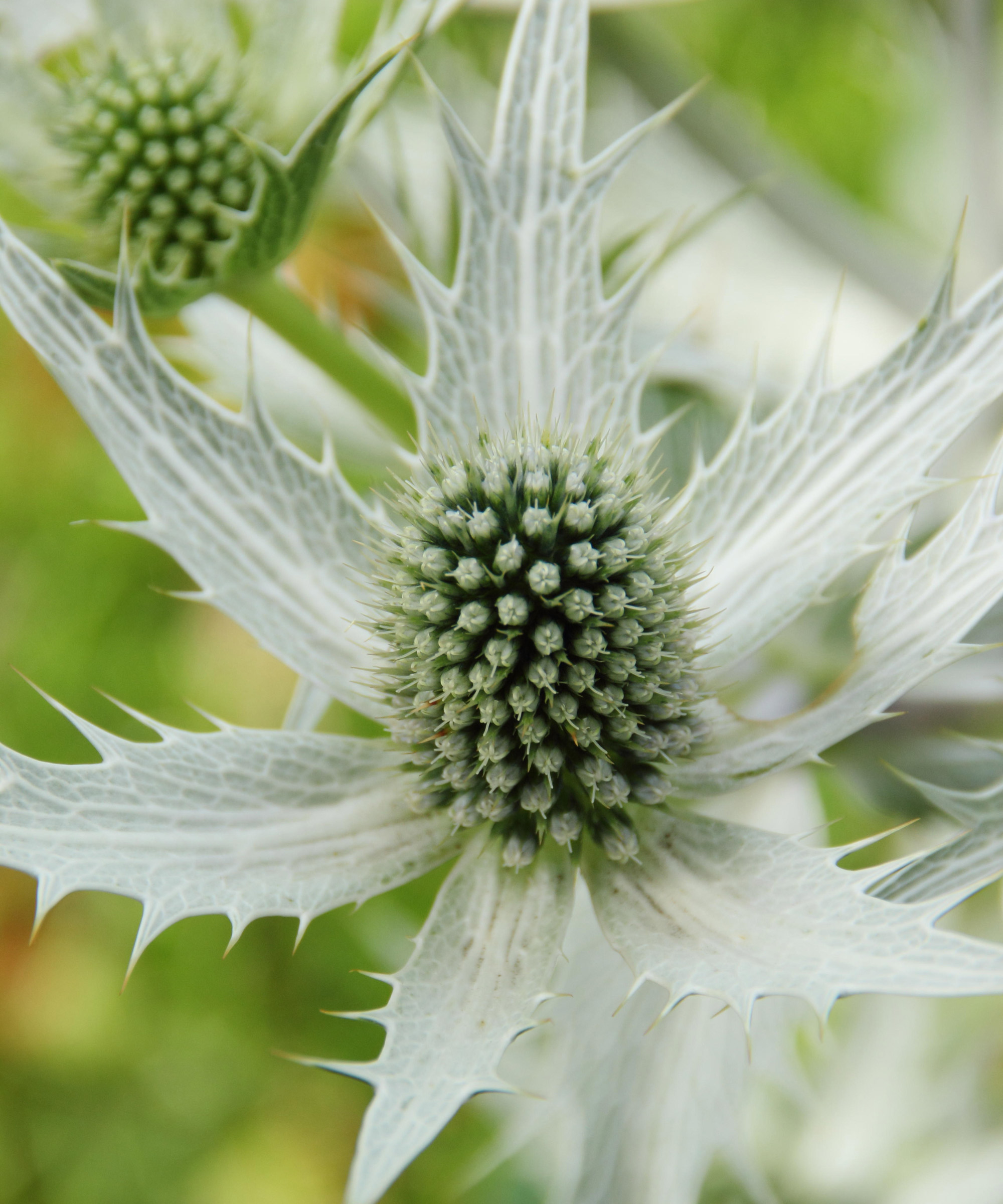
‘Silver Ghost’ AGM
- Hardiness: USDA 4-7 (UK H6)
- Height: 3ft (90cm)
- Spread: 1.5ft (45cm)
- Best for: self-sowing silver border
For those in search of a smattering of silver sparkle for their garden, this self-sowing biennial is one of the most translucent sea hollies you can try. ‘Silver Ghost’ AGM is a larger, more silvery form of the original Miss Willmott’s Ghost, so-called because horticulturist Ellen Willmott allegedly scattered E. giganteum in people’s gardens.
‘Silver Ghost’ is also one of the best foliage plants in this selection. As well as possessing pale-grey cones, wide bract, and stems that are truly breathtaking at twilight on summer evenings, this plant has distinctive narrow foliage. In very well-drained soil, it can self-sow with gusto.
- Buy ‘Silver Ghost’ in the US: view at Amazon.com
- Buy ‘Silver Ghost’ in the UK: view at Plants Of Distinction
5. E. maritimum
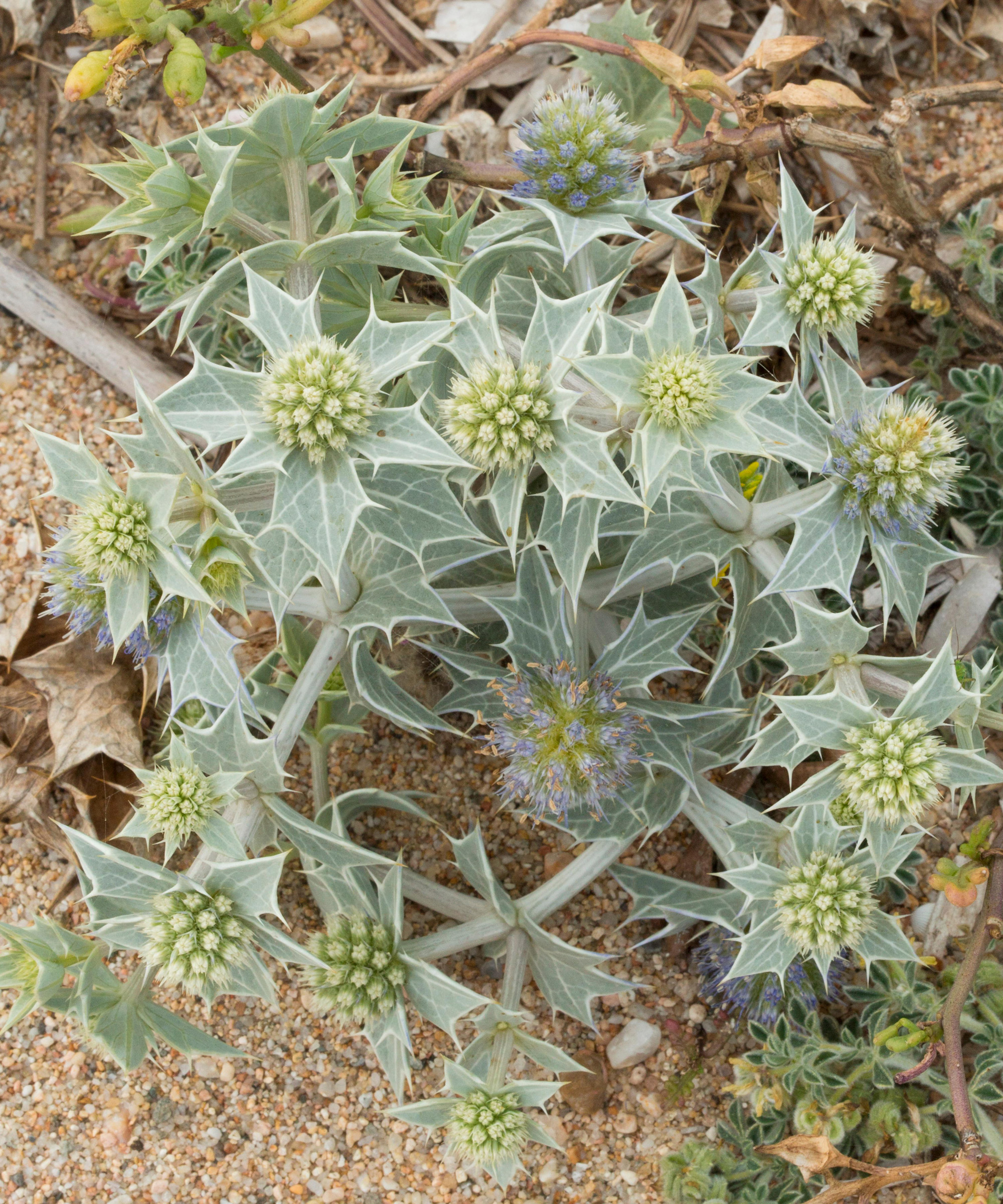
E. maritimum
- Hardiness: USDA 5-9 (UK H5)
- Height: 18in (45cm)
- Spread: 24in (60cm)
- Best for: gravel gardens
This definitive eryngium thrives in tough situations. It is one of the best coastal plants and loves sandy and shingle-based surroundings. In the wild, it grows on sand dunes and therefore requires well-drained soil in full sun, making it a great plant for the front of a gravel garden.
Our native sea holly has soft violet-blue flowerheads above waxy blue-grey foliage that is rimmed with spikes. E. maritimum looks especially good growing alongside poppies, but don’t sow them too close, as this eryngium appreciates elbow room.
6. E. variifolium
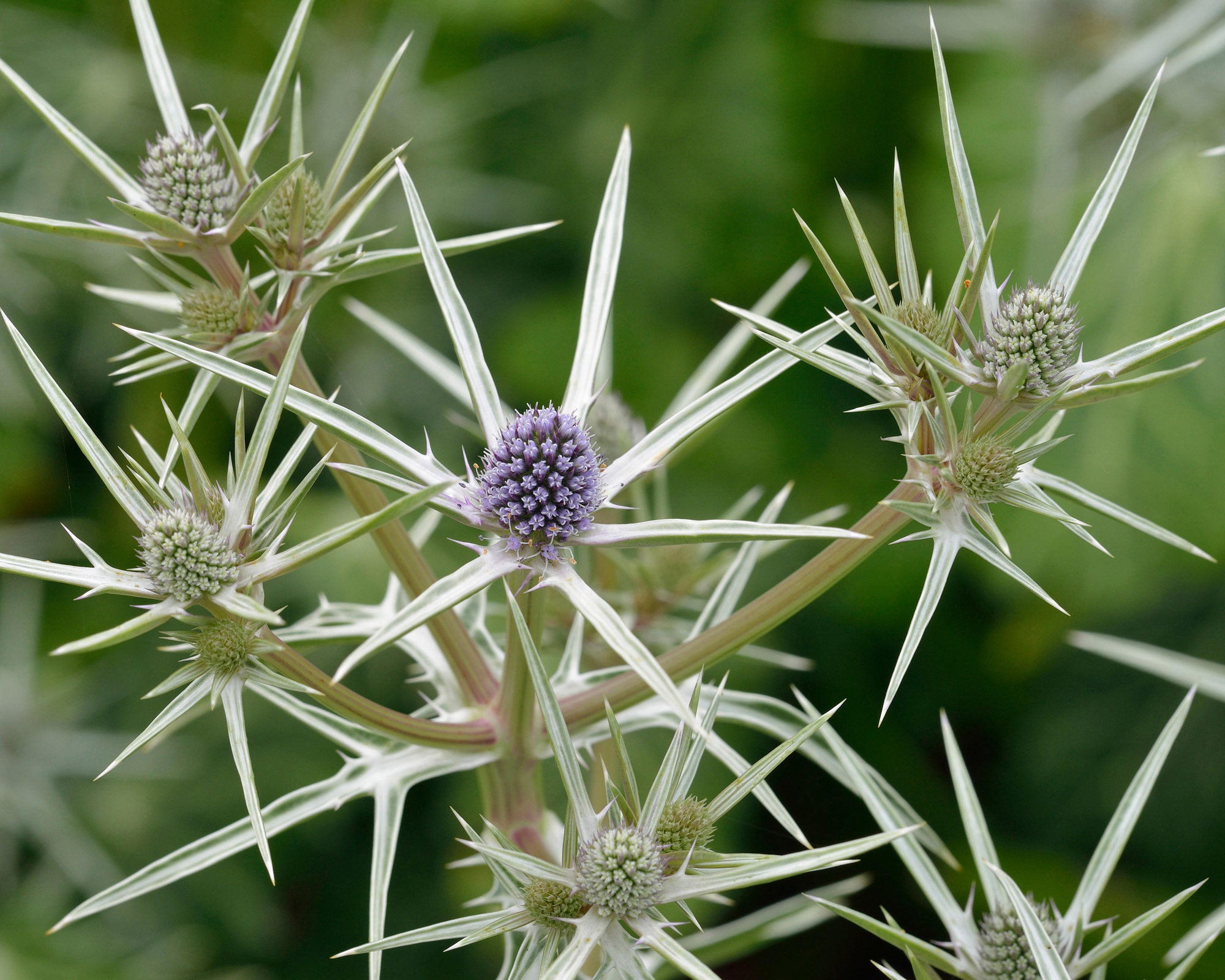
E. variifolium
- Hardiness: USDA 5-9 (UK H4)
- Height: 18in (45cm)
- Spread: 12in (30cm)
- Best for: contemporary gardens
Also known as Moroccan sea holly, E. variifolium is a superb evergreen sea holly from the Atlas Mountains of Morocco. This sparkly variety has a subtle architectural quality. For those who like plants with frosted foliage, this eryngium’s green foliage with its grey-white veins has the effect of being sprinkled in silver.
E. variifolium also stands out for having small lavender cones with wide slender bracts that resemble stars and also look frosted. The whole effect is a metallic silver mass with a rugged, contemporary look. It pairs well with Mexican fleabane in well-drained soil.
7. Picos Amethyst
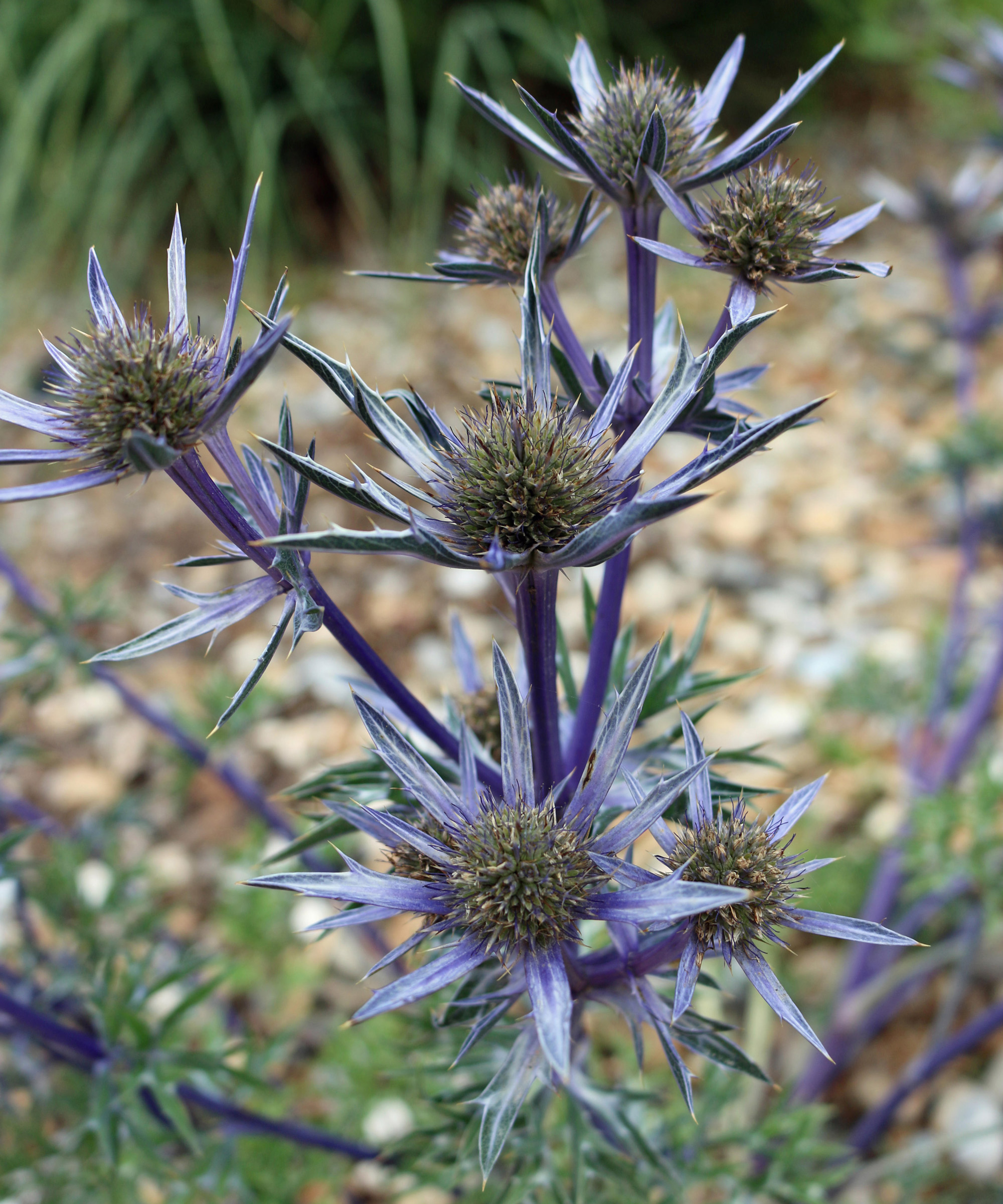
Picos Amethyst
- Hardiness: USDA 5-8 (UK H5)
- Height: 22in (55cm)
- Spread: 4in (10cm)
- Best for: beginners
There are several very pretty violet sea holly varieties worth considering, and E. bourgatii Picos Amethyst is a great all-rounder for the garden. This eryngium has crisp, white-veined leaves and steely blue flowers, all set off nicely by rich maroon stems.
Sea hollies make some of the best plants for pollinators and dramatic thistle-style Picos Amethyst is especially eye-catching. Bees and butterflies love this long-flowering beauty, and it also gives a great effect over winter. It’s easy to grow in a sunny spot in average well-drained soil.
8. ‘Jade Frost’ AGM
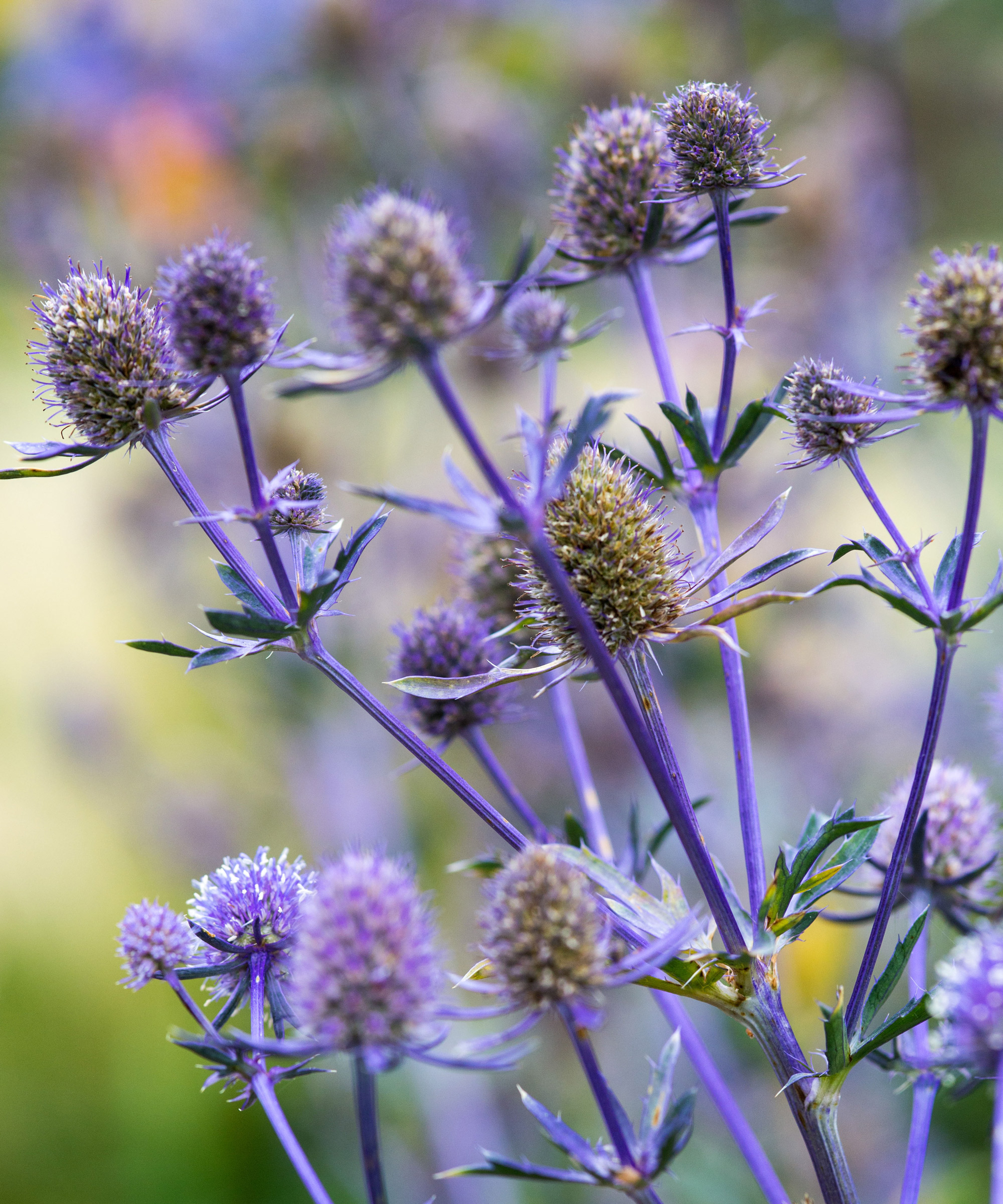
‘Jade Frost’
- Hardiness: USDA 4-8 (UK H5)
- Height: 30in (75cm)
- Spread: 12in (30cm)
- Best for: violet foliage
Lovers of purple flowers will appreciate this violet eryngium. E. planum ‘Jade Frost’ has small thistle-like silver summer flowers that morph to azure-purple atop violet stems, and all above interesting variegated green and cream leaves that can flush pink in winter.
Grow this perennial alongside both dainty and highly textured types of euphorbia in well-drained soil in full sun. Leaving the stems in situ in the fall will provide stark silhouettes over winter and it will also provide a pretty habitat for insects.
9. ‘Violetta’
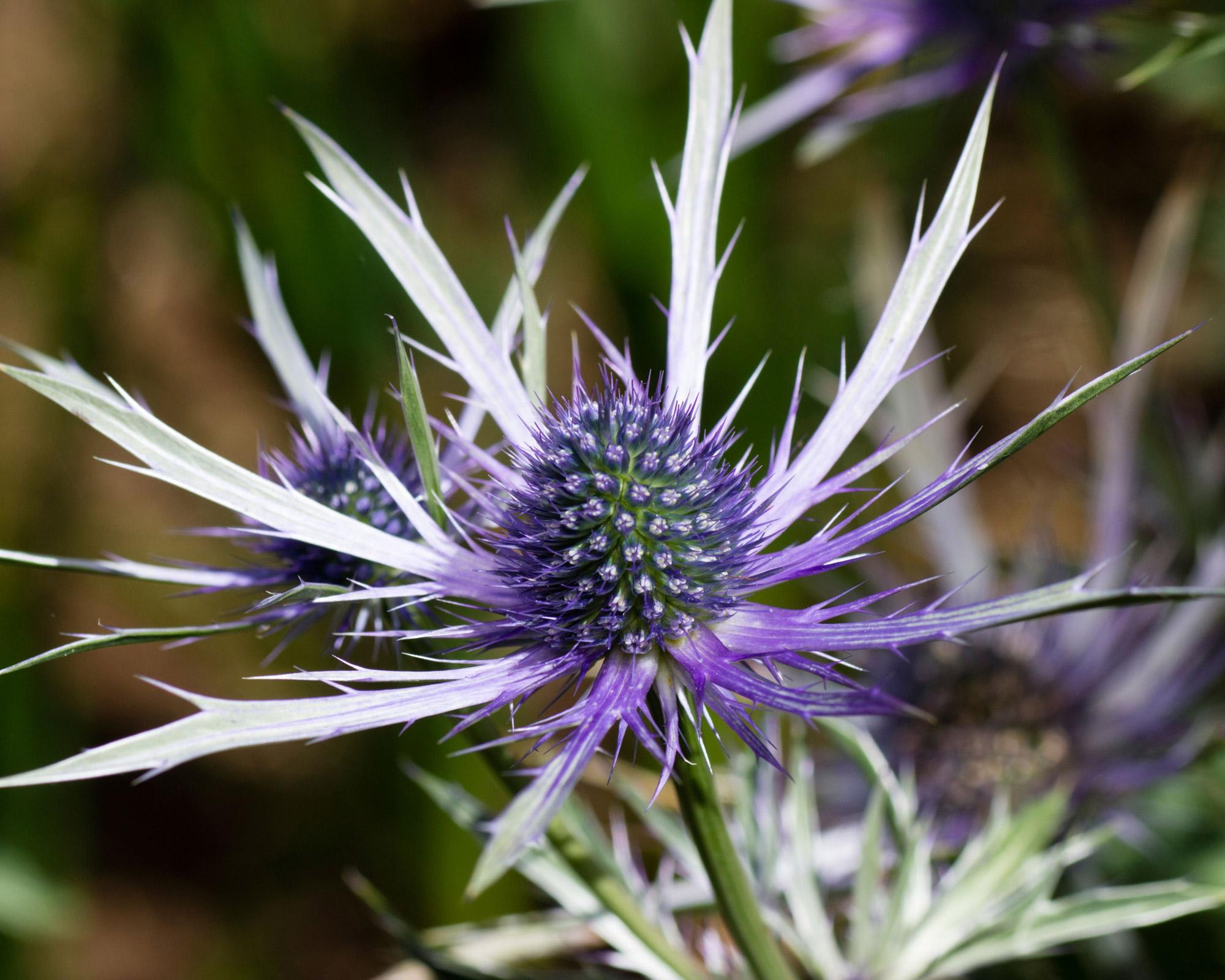
‘Violetta’
- Hardiness: USDA 5-9 (UK H5)
- Height: 27in (70cm)
- Spread: 15in (40cm)
- Best for: bees
E. × zabelii ‘Violetta’ is one of the most dramatic types of eryngium you can try. Glowing purple flowers with violet-blue bracts are held aloft on blue branching stems with spiny silver-green leaves. This sea holly is especially effective if combined with verbena in well-drained soil.
If you’re looking for the best plants for seed heads, this semi-evergreen variety is ideal. Following a vibrant injection of color in mid to late summer, its seed heads provide plenty of architectural interest in winter. As with most sea hollies, this thistle-shaped beauty also provides food for bees.
10. E. alpinum
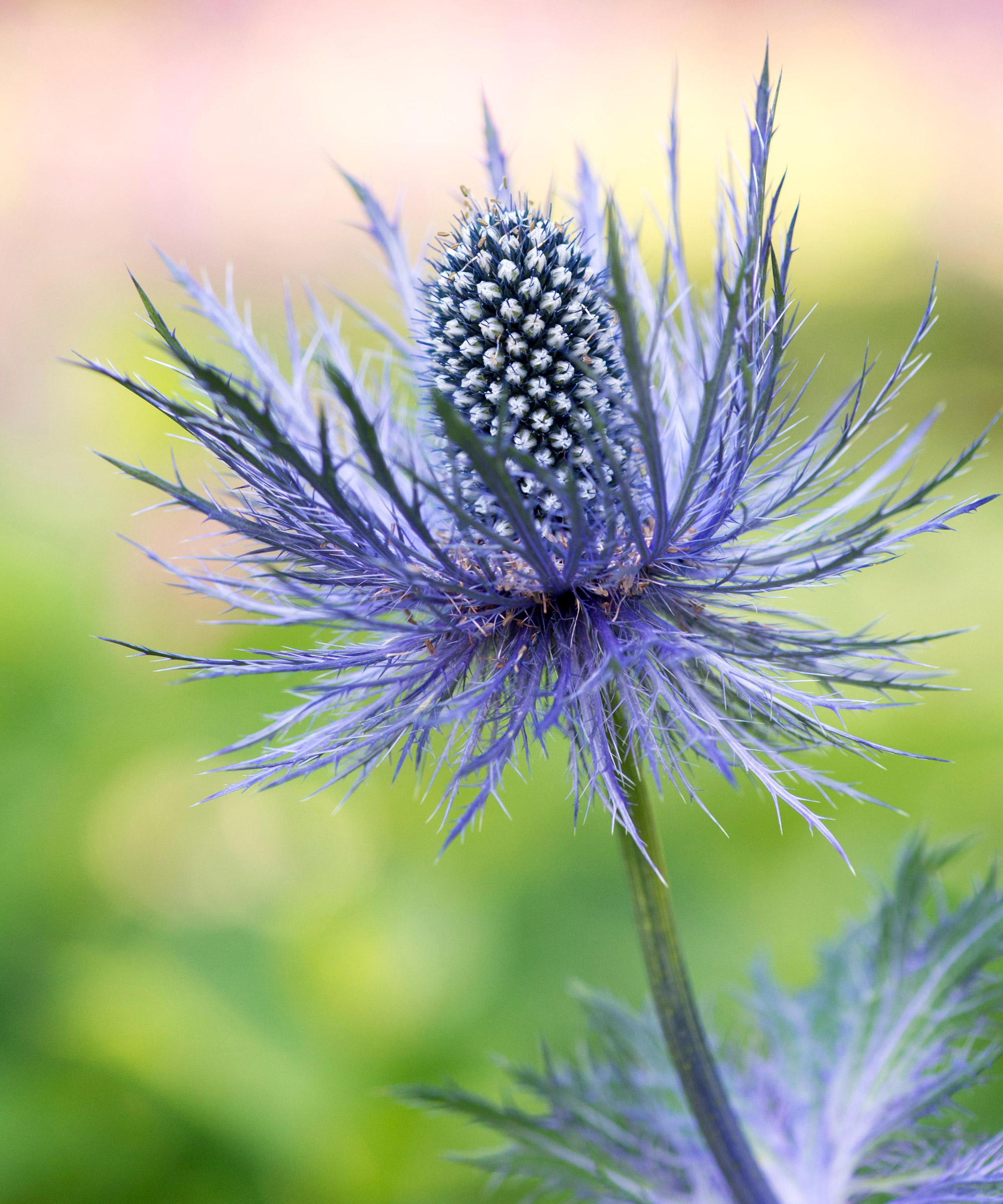
E. alpinum
- Hardiness: USDA 3-8 (UK H5)
- Height: 31in (80cm)
- Spread: 18in (45cm)
- Best for: dried flowers
If you’re looking for a sea holly that present with gorgeous ruffs, this is one of the fluffiest. The alpine eryngium has big cone flowerheads surrounded by wonderful large, soft, lacy ruffs. These take on blue and purple tones atop bluish stems. The effect is that of a glamorous thistle.
E. alpinum is perhaps the best species for dried flowers and cutting garden flowers in this selection. This delightful sea holly also provides food for bees in late summer and early fall. Grow in an open spot in full sun, and plant alongside both soft and structured grasses.
- Buy E. alpinum in the UK: view at Thompson & Morgan
- Buy E. alpinum ‘Blue Ice’ in the UK: view at Suttons Seeds
11. ‘Pen Blue’
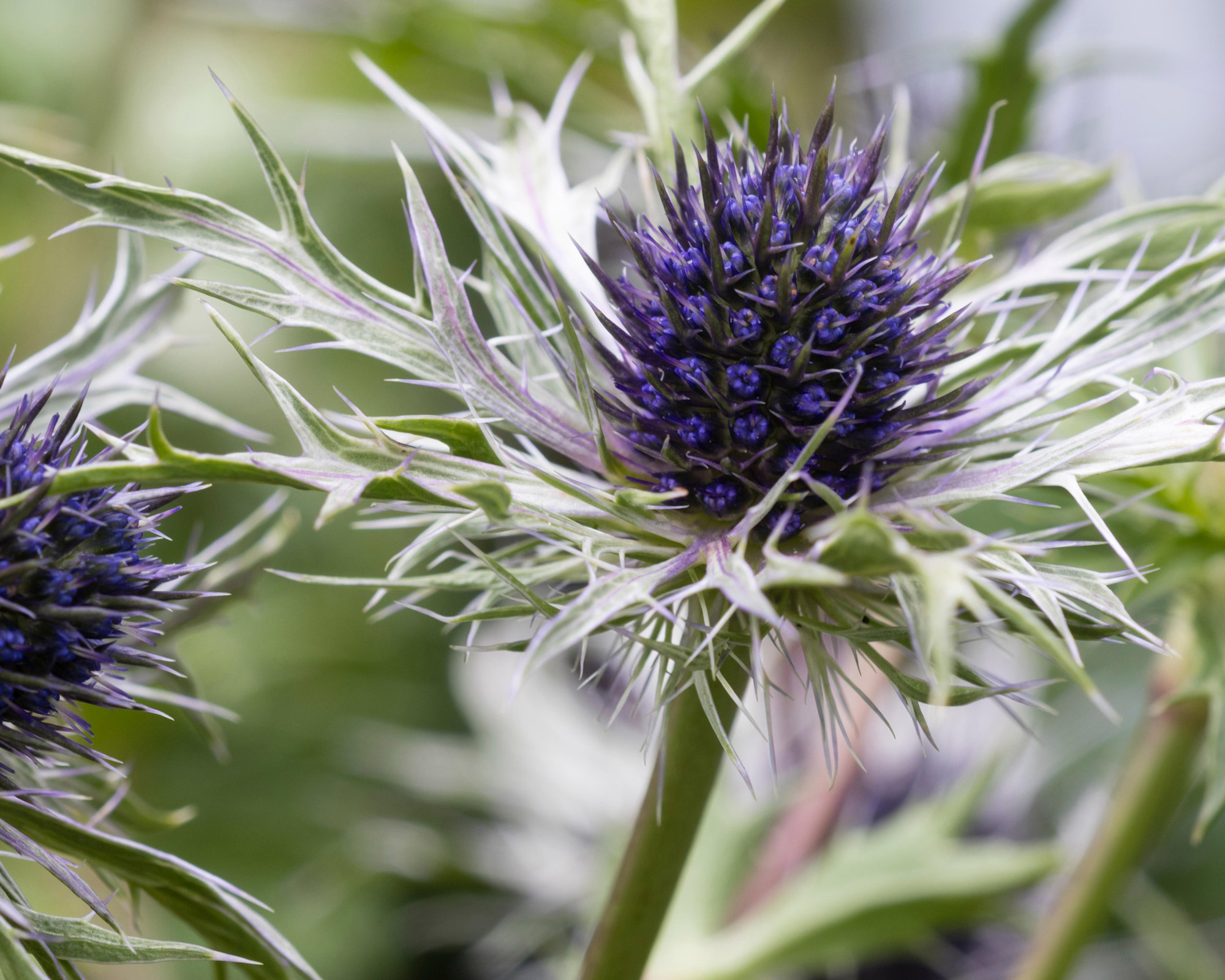
‘Pen Blue’
- Hardiness: USDA 4-8 (UK H5)
- Height: 20in (50cm)
- Spread: 15in (40cm)
- Best for: big ruffs
There is something almost otherworldly about the next eryngium in our roundup. ‘Pen Blue’ has thimble flower heads surrounded by a ruff of slender spikes, which combined make this sea holly resemble a mass of stars. It begins silver and matures to violet blue later in the summer.
If you’re looking for inspirational plant pairings, white flowers work well with this sea holly. It also looks lovely paired with Oenothera lindheimeri in well-drained soil. To enjoy them as dried flowers, wait until the color intensifies, then cut and hang upside down for a fortnight.
- Buy ‘Pen Blue’ in the US: view at Kilmurry Nursery
- Buy ‘Pen Blue’ in the UK: view at Jackson Nurseries
12. E. x oliverianum AGM
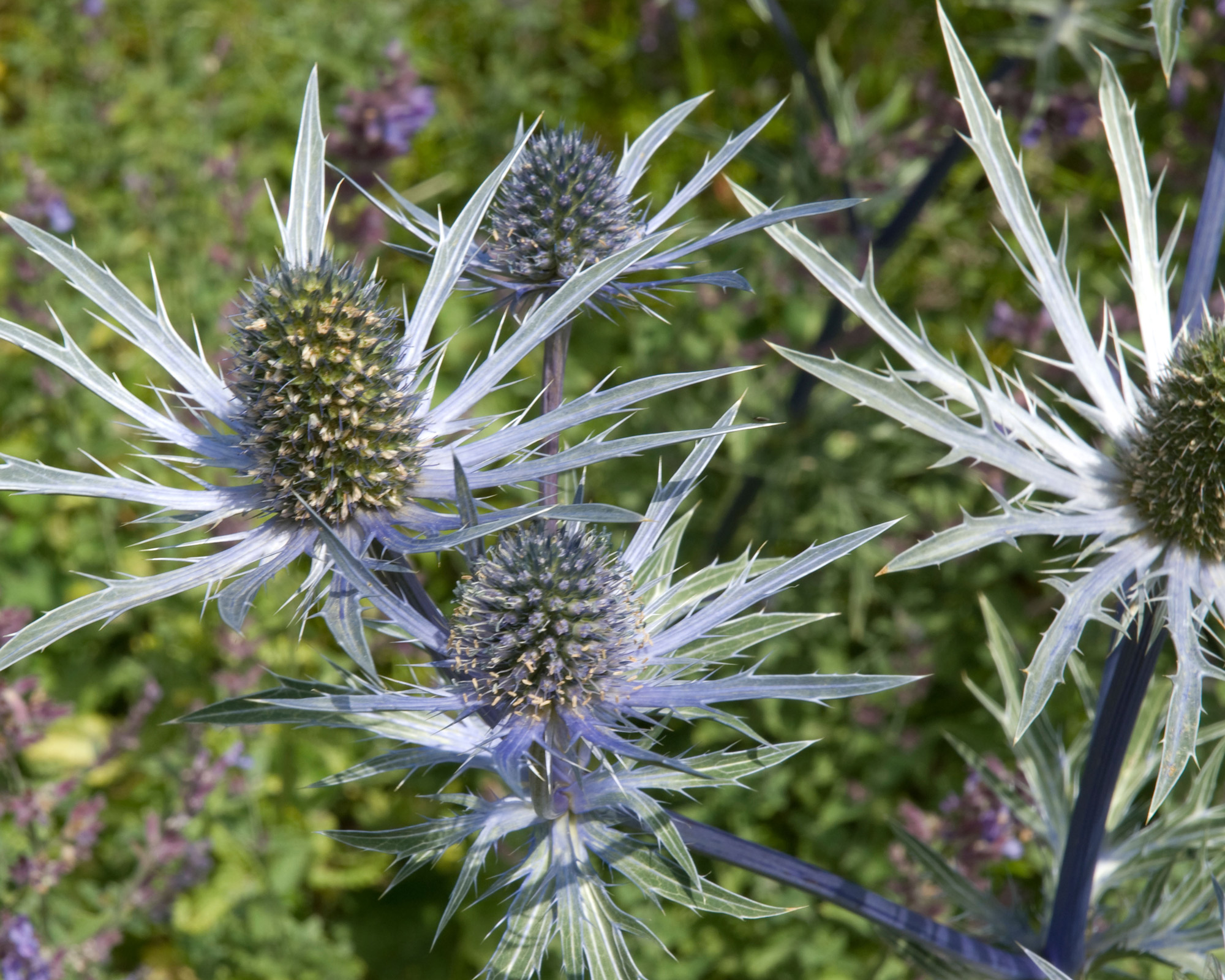
E. x oliverianum AGM
- Hardiness: USDA 4-8 (UK H5)
- Height: 3ft (90cm)
- Spread: 2ft (60cm)
- Best for: metallic sheen
Another excellent sea holly for cutting and drying, this variety also looks lovely if you leave the flower heads to provide structure in the border in winter. For lovers of verbascum, these eryngium varieties are perfect planting partners, grown in an open, well-drained and sunny spot.
When in bloom, E. x oliverianum develops lush rich-blue flowerheads on indigo stems, hovering above a basal clump of green leaves in summer. When the sun shines, this sea holly produces a wonderful metallic-blue shimmer in the border.
13. E. yuccifolium
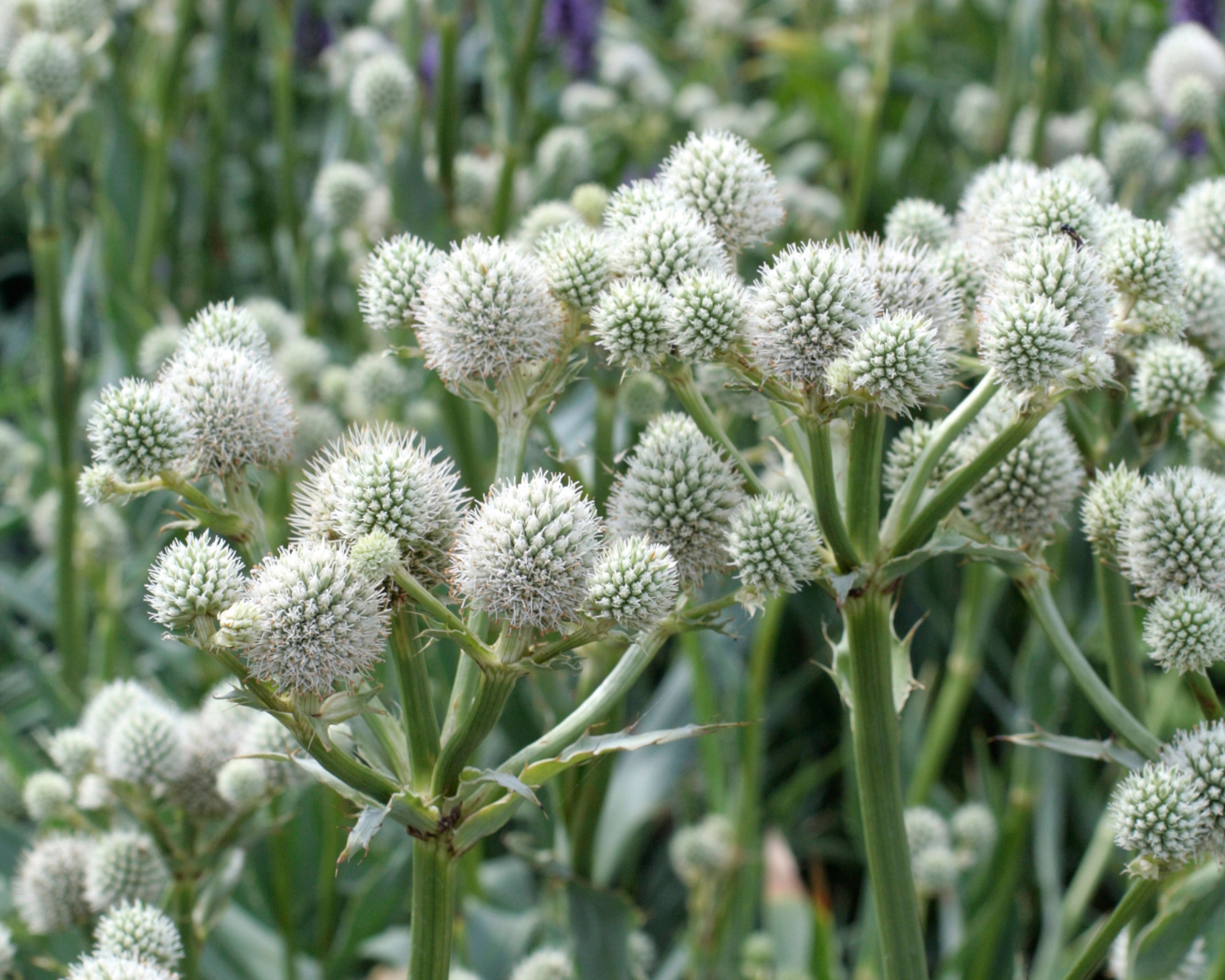
E. yuccifolium
- Hardiness: USDA 3-8 (UK H4)
- Height: 4ft (1.2m)
- Spread: 2ft (60cm)
- Best for: seed heads
The weird and wonderful rattlesnake master (E. yuccifolium) has clusters of small egg-shaped lime-ivory flowerheads above a mass of sword-shaped grey-green leaves in summer and early fall. So for lovers of green flowers, this is an excellent perennial planting option.
This excellent evergreen is native to the US and is one of the best sea hollies for attracting pollinators such as butterflies. If you’re looking for inspirational planting partners, grow with phlomis in open, undisturbed soil that is well-drained and baked by the sun.
- Buy E. yuccifolium ‘Rattlesnake’ in the US: view at Amazon.com
- Buy E. yuccifolium in the UK: view at Crocus
14. E. agavifolium
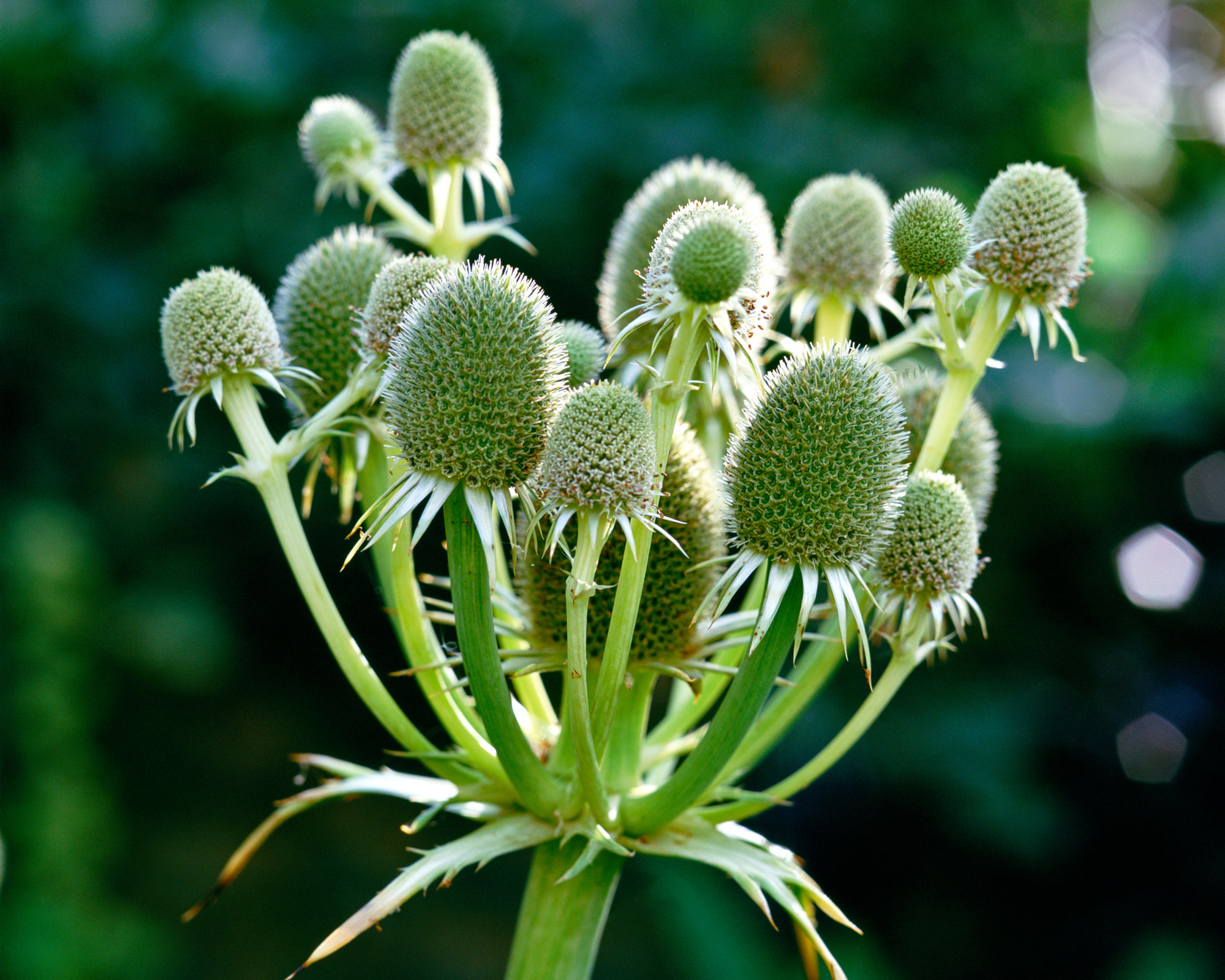
E. agavifolium
- Hardiness: USDA 5-9 (UK H4)
- Height: 5ft (1.5m)
- Spread: 2ft (60cm)
- Best for: coastal gardens
Also perfect for pollinators, the agave-leaved sea holly (E. agavifolium) is a nectar-rich species from Argentina. If you’re looking for the prettiest and most dynamic bee-friendly plants, this eryngium is one of the finest and most unusual you can choose.
This exotic architectural plant develops cream cones of flowers atop sturdy stems that rise out of a dense rosette of serrated fleshy evergreen leaves. Loving well-drained soil, this sea holly is perfect in a gravel garden alongside Dianthus carthusianorum.
15. E. pandanifolium ‘Physic Purple’
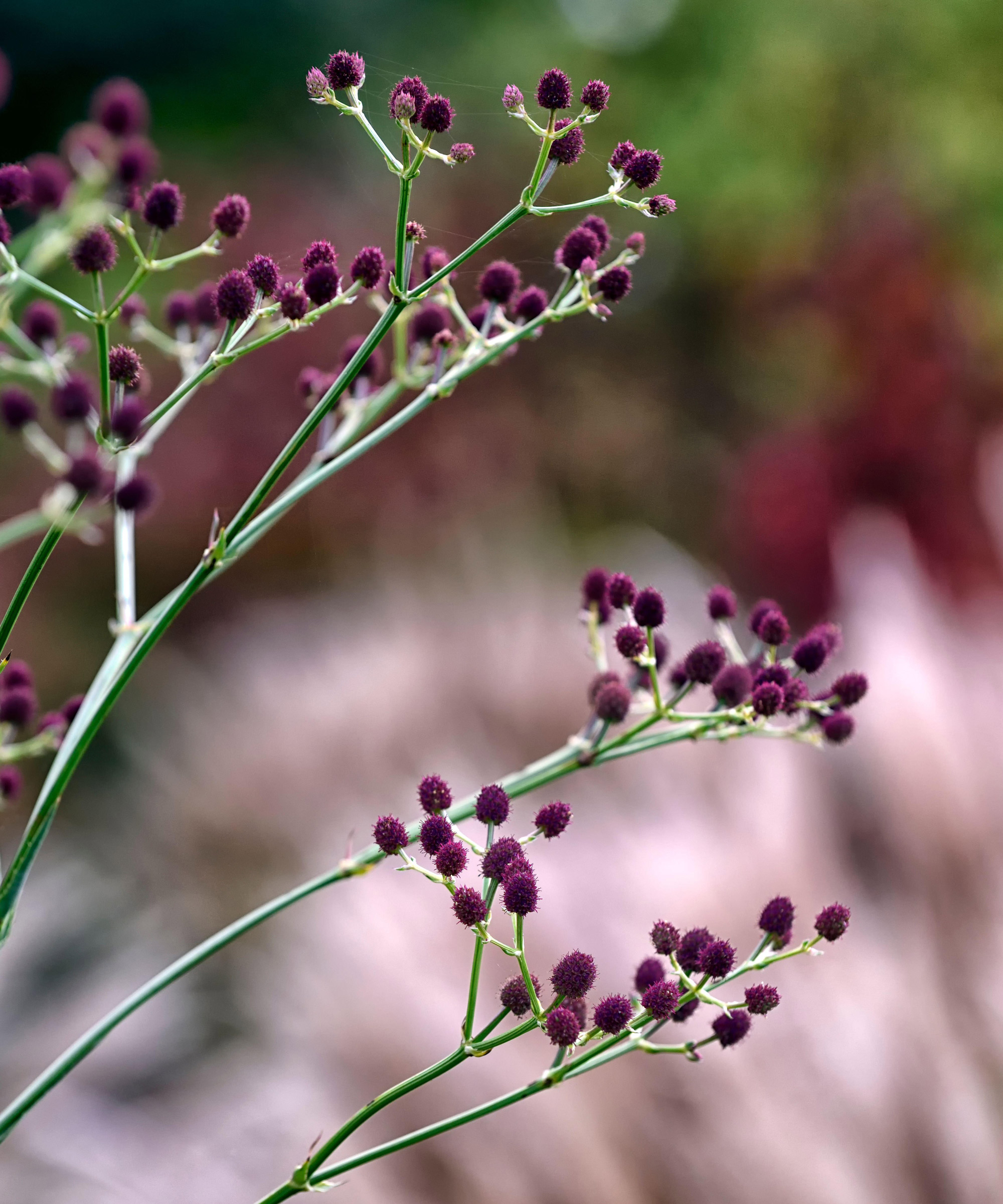
‘Physic Purple’
- Hardiness: USDA 5-9 (UK H4)
- Height: 8ft (2.5m)
- Spread: 5ft (1.5m)
- Best for: retentive soil
If you’re looking for the best fall flowers and plants, E. pandanifolium ‘Physic Purple’ is an excellent choice. This colossal architectural plant produces a mass of spiky sword-like glaucous leaves out of which soar branching stems bearing plum-colored thimbles of flowers in the fall.
Unlike most eryngium, this variety appreciate a moist, well-drained soil during summer, although they dislike waterlogging in winter. For the perfect plant partners, try growing these eryngiums with tall grasses in the sunshine.
16. E. eburneum
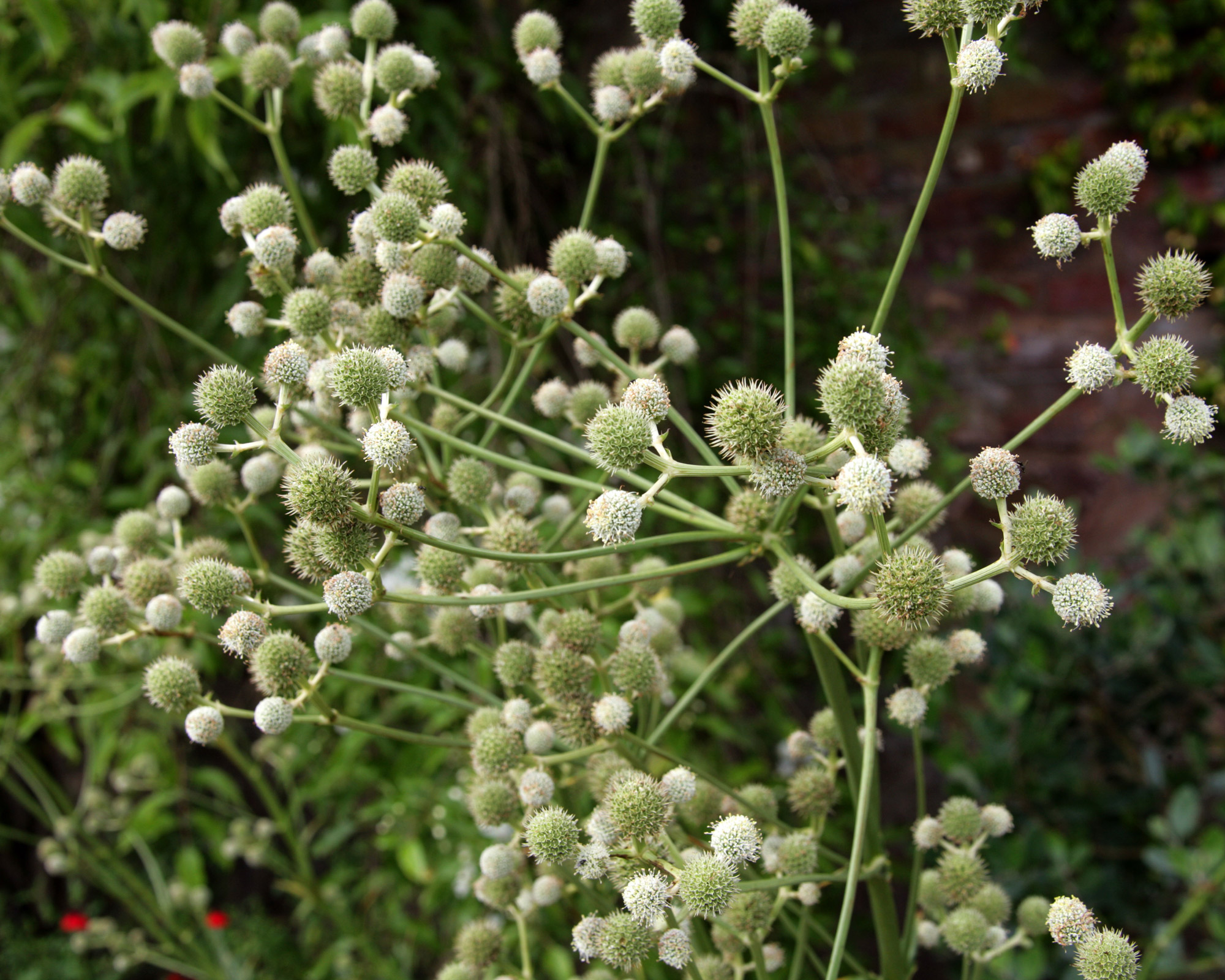
E. eburneum
- Hardiness: USDA 5-9 (UK H4)
- Height: 4ft (1.2m)
- Spread: 2ft (60cm)
- Best for: naturalistic gardens
E. eburneum is a delightful sea holly with a coarse, modern look. If you are a fan of the wildflower meadow planting style, this South American species is a must-have for naturalistic perennial borders. They are tolerant of moisture-retentive soil, but require good drainage and sun.
These types of eryngium develop airy heads of green-white flower thimbles. These are widely spaced like an atomic model atop tall stems, above an attractive mass of long, slender green leaves. The yellow-tinged ivory white sea holly is a prolific and enchanting flowering choice.
Which of the sea holly varieties is the most blue?
While sea hollies can be bred for exquisite silvers and subtle violets, they are often most readily identifiable for their blue tones. ‘Lots of eryngiums are strikingly blue,’ say Brian and Kathy Pike, who hold the UK National Collection of Eryngiums in North Yorkshire. However, the Eryngium x zabelii group contains some of the bluest. Brian and Kathy recommend you try cultivars such as ‘Big Blue’ and ‘Forncett Ultra’.
According to the late, great gardener Christopher Lloyd, who created the famous Great Dixter garden, E. x oliverianum was the best blue sea holly you could grow. Lloyd believed that the color of eryngiums was bolder in full sun, so bear this in mind with your selections. Other gardeners report that dry conditions can also amplify the intensity of the blues that sea hollies are capable of developing.
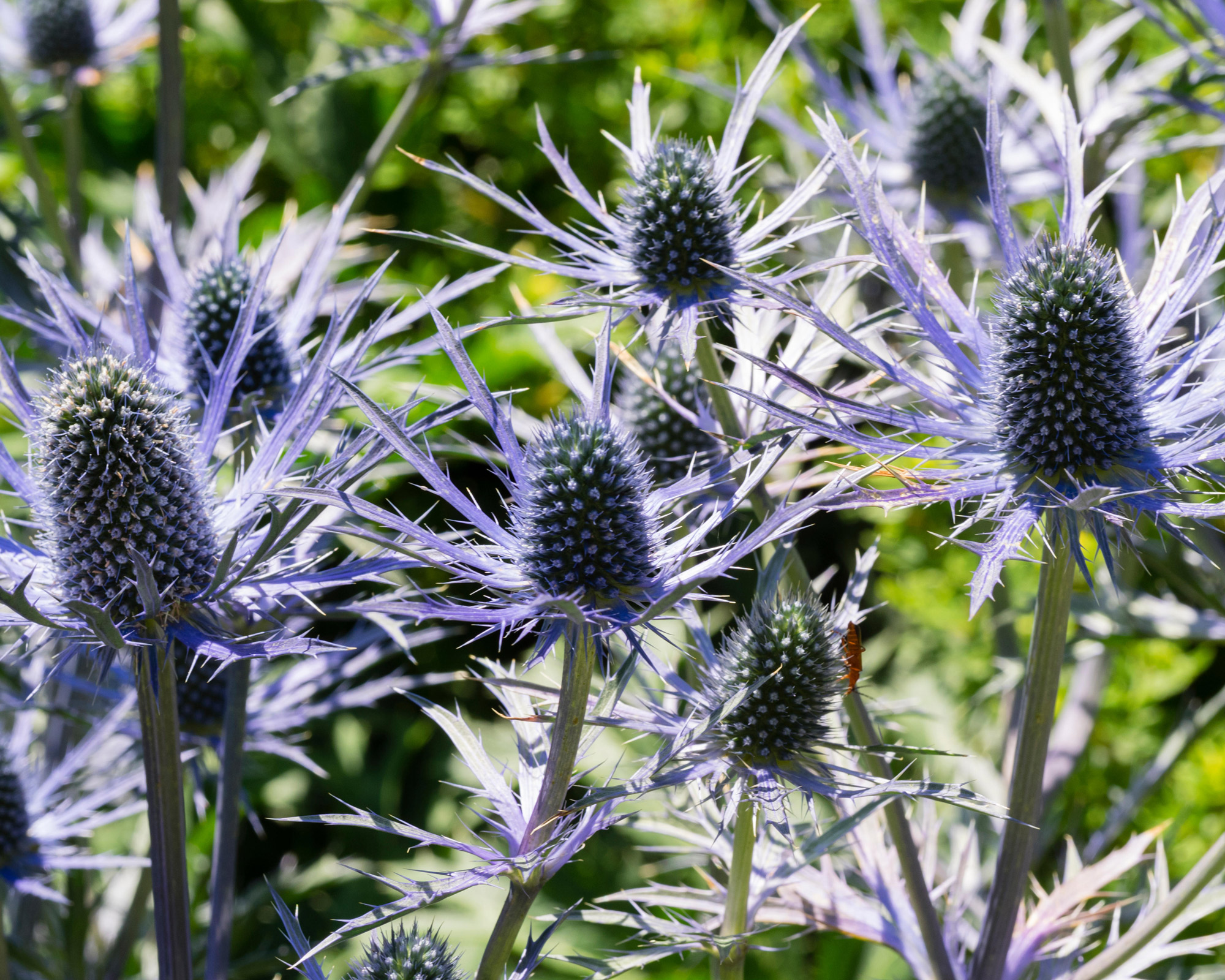
E. x zabelii ‘Forncett Ultra’ is a vibrant metallic blue
Which sea holly varieties are tallest?
Some strap-leaved New World species of sea holly can send up flower stems that are 6-10ft (2-3m) high, according to Brian and Kathy Pike. These sea holly varieties include E. pandanifolium (aka giant sea holly), E. paniculatum, and E. horridum. E. pandanifolium grow to 8ft (2.5m) tall, while E. paniculatum and E. horridum can reach 5ft (1.6m) high.
For an impactful and dramatic show when landscaping with flowers for height, try E. pandanifolium 'Physic Purple’. This towering eryngium is a delicate yet stunning mass of wine-colored thimble flowers, reaching 8ft (2.5m) tall or higher.
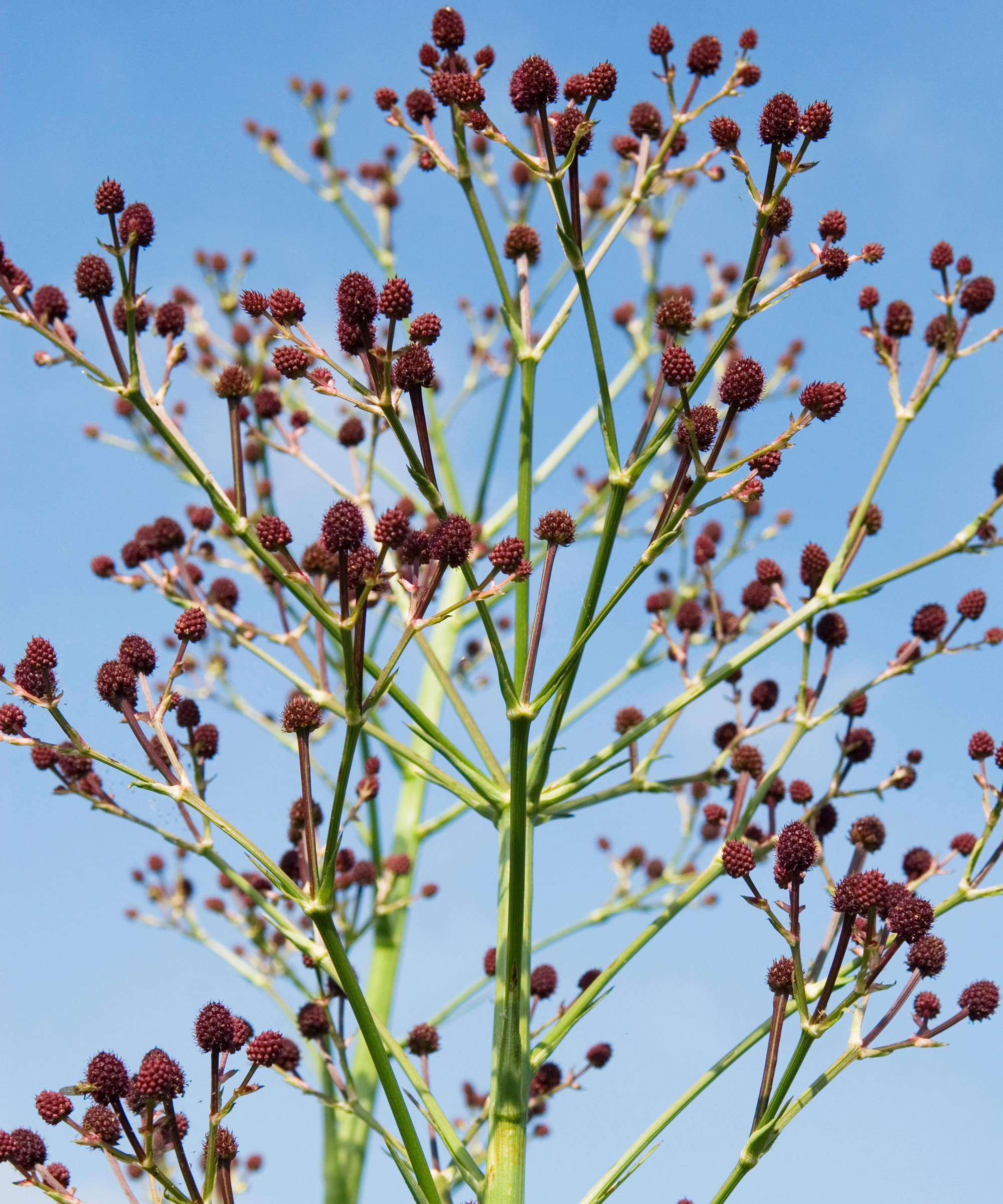
E. pandanifolium ‘Physic Purple’ has towering, branching stems with masses of tiny flowers
Are any sea holly varieties evergreen?
If you are looking to enhance your landscaping with evergreens , there are some sea holly varieties that will go the distance all year round. It’s just a matter of picking the right breeds. As Brian and Kathy point out, the Old World species – apart from E. variifolium – die back over winter. However, the New World species are evergreen.
The evergreen foliage of both E. agavifolium and E. yuccifolium is particularly striking. E. agavifolium develops a dense rosette of serrated fleshy evergreen leaves, while E. yuccifolium presents a mass of sword-shaped grey-green foliage.

As assistant editor of Amateur Gardening magazine, Janey's gardening passion was fostered from an early age, when her amazing mum had her deadheading hydrangeas, mulching roses, and propagating strawberry plants from runners for school open days. She's also taken part in lots of conservation and rewilding projects for the RHS and TCV as a way of exploring her horticultural horizons.
